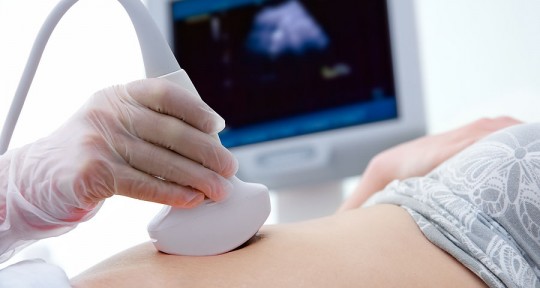Ultrasound
 Overview
Overview
Prenatal diagnosis refers to tests that are performed during pregnancy to diagnose certain birth defects or genetic disorders. Tests such as amniocentesis, chorionic villus, sampling (CVS), maternal 21 testing, alpha-fetoprotein (AFV), and ultrasound can provide important information about the fetus. Blood tests on parents can evaluate the risk of certain genetic diseases that can be passed on to the fetus.
Ultrasound
Ultrasound is the use of sound waves to make medical diagnostic images of the fetus. It is used before and during amniocentesis. Ultrasound is also used in CVS to assist the doctor during the procedure. We also evaluate the fetal anatomy; however, in at least 30% of pregnancies, not all organ systems can be clearly seen at the time of the amniocentesis. The best time to perform a detailed anatomical evaluation of the fetus is between 18-22 weeks, which is three to five weeks after the usual time for amniocentesis. Typically, the purpose of ultrasound is to evaluate the brain and heart anatomy movements and fetal face.
- First trimester screening is done between 11-13 weeks, checking for down syndrome. Trisomy 13-18
- Approximately 2-3% of babies have a birth defect which can range from mild to severe. Ultrasound can potentially detect 30-50% of these birth defects if the organs can be seen.
- The majority of all birth defects occur with no family history, i.e. in low-risk pregnancies.
- In some high-risk situations, early evaluation may be indicated, with a repeat ultrasound at a later gestational age. Your genetic counselor or Dr.Kahen can advise you on timing.
- The best time for fetal cardiac evaluation is 20-22 weeks.
Genetic Counseling
Genetic counseling is offered to patients who are considering prenatal testing. During the interview, the counselor reviews the family history to determine if the pregnancy is at increased risk for specific birth defects or genetic diseases. Medical records may also be reviewed. This process helps the couple to decide which, if any, prenatal tests they wish to have.
Amniocentesis
Amniocentesis is the removal of a small amount of fluid that surrounds the fetus. This procedure is usually performed around 16 to 17 weeks of pregnancy. Some patients may be evaluated for early amniocentesis at 12 to 13 weeks, generally because of an increased risk factor or as an alternative to CVS. Amniocentesis can routinely detect major chromosome abnormalities (like Down syndrome) and neural tube defects (spina bifida and related defects). We may offer testing for other genetic disorders when there is a family history or if abnormalities are found on ultrasound. Amniocentesis is performed in the ultrasound room. To avoid touching the fetus, ultrasound is used to guide the doctor in inserting a thin needle into the woman’s abdomen. The needle is carefully placed in the amniotic sac and about one tablespoon of fluid is removed. The sample is sent to a lab where the cells are grown and examined. The results are usually available within two weeks. The procedure may cause slight discomfort such as cramping or pressure. For most women the experience is much easier than expected. Although amniocentesis is fairly safe, it does carry some risks. Side effects include cramping and fatigue. Other possible but rare complications include leakage of fluid, bleeding, and infection , as well as a small risk of miscarriage (1/400). Of course, all pregnancies carry a risk of miscarriage, whether the patient has the test or not. You can reduce the risk of miscarriage by ensuring that the performing doctor is very experienced and has a low complication rate.
Indications for Amniocentesis
- Women who are 35 or older when their baby is due.
- Women who have had an abnormal first or second trimester screen.
- Increased nuchal translucency.
- Any couple who has had a previous child with Down syndrome or other chromosome abnormality.
- Any couple who has had a previous child with spina bifida or anencephaly.
- Any couple for whom one parent has a known chromosome rearrangement.
- Women at risk for a child with a genetic condition such as hemophilia, muscular dystrophy, Tay-Sachs, cystic fibrosis, or a hemoglobinopathy.
- Women who take certain medications to control seizures.
*There are many other reasons for prenatal diagnosis. Discuss your own risk factors with Dr.Kahen
Chorionic Villus Sampling
CVS is the removal of a small sample of tissue from the placenta, using a thin catheter inserted through the cervix (entrance to the uterus) or inserted abdominally. This procedure is usually done at 10 to 12 weeks of pregnancy. CVS can detect major chromosome abnormalities and some genetic disorders. It cannot detect neural tube defects, but a maternal blood test (AFP) later in pregnancy can screen for such defects. The advantage of CVS is that it can be performed earlier than amniocentesis. However, CVS involves slightly higher risks for miscarriage. Rare cases of limb deformities have also been reported.
Safety of Amniocentesis & CVS
There is a small risk of pregnancy loss after amniocentesis or CVS. Those tests are generally offered only if the potential benefit of the test outweighs the risk. This procedure is done by high risk obstetrics specialist called a Perinatologist.
Fetal Cardiac Scan Indications
A fetal cardiac scan, also called a fetal echocardiogram, is offered if there is a particular concern regarding heart development.
- Family history of congenital heart disease.
- Diabetes (insulin dependent) existing prior to pregnancy or diagnosed in early pregnancy.
- Increased nuchal translucency.
- Abnormality in another major organ system.
- Drug exposure, i.e. lithium, Accutane, some hormones, anti-seizure medication, alcohol, vitamin A.
- Polyhydramnios (increased amniotic fluid).
- Oligohydramnios (decreased amniotic fluid).
- Intrauterine growth retardation (fetus not growing normally).
- Multiple gestation (identical twins or twins or triplets).
- Chromosome abnormalities.
- Fetal heart arrhythmia.

